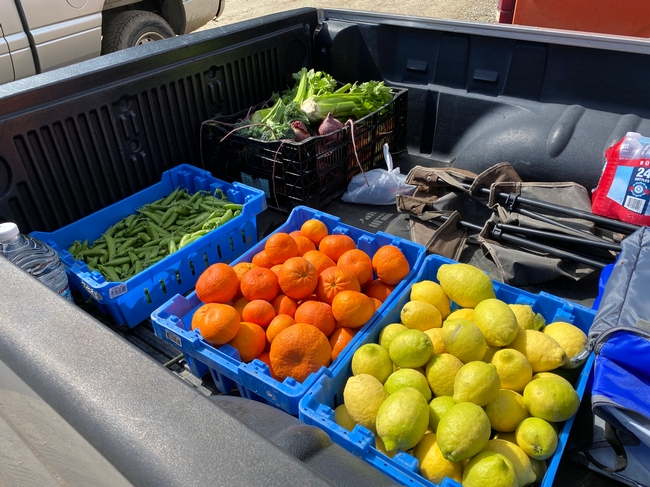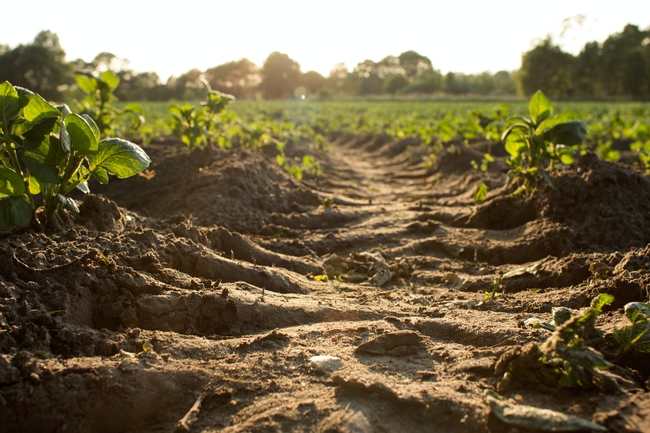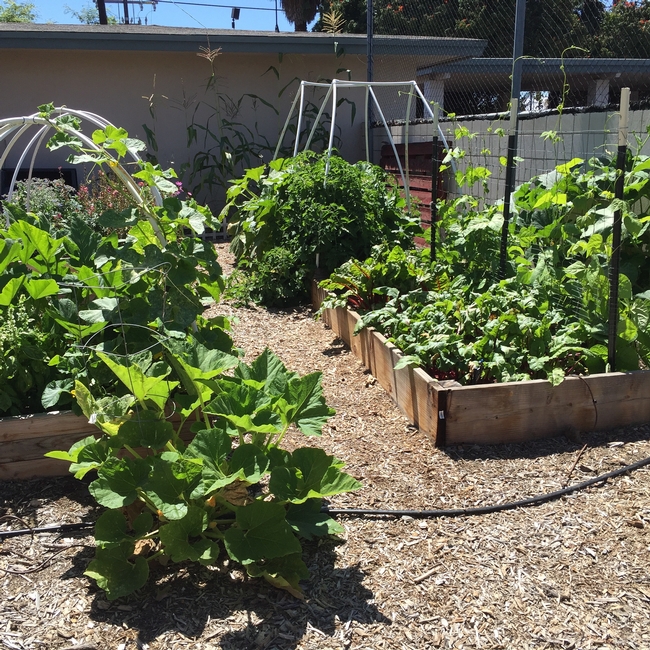
Posts Tagged: covid-19
UC HAREC Donates Fruits and Vegetables to Food Forward and Ventura Schools
Nearly two tons of fruit and vegetables grown at UC's Hansen Agricultural Research and Extension Center (HAREC) in Santa Paula have been donated to Food Forward and the Ventura Unified School District (VUSD), destined for children and families.
Some of the vegetables – planted by volunteers and farm staff - became available when UC HAREC's farm field trips were canceled due to COVID-19. Other vegetables were harvested from the student farm located at HAREC, a partnership with VUSD and the city of Ventura. Kale and lettuce at the student farm were planted by youth from DATA and Montalvo schools.
Every fall and spring, volunteers from the UC Master Gardener program propagate seedlings for schools, bundling them into variety packs of vegetables and herbs, which are given to schools with gardens. Because of COVID-19, plants were given to schools for direct distribution to families. Ventura Unified School District staff partnering in this effort include Kara Muniz, Director of Food and Nutrition Services; Ashely Parrish Decker, Nutrition Educator, who runs the Student Farm; and Alise Echles, RDN.
Additional fruit and vegetables were harvested from HAREC's citrus demonstration area, the site's educational gardens and the farm grounds.
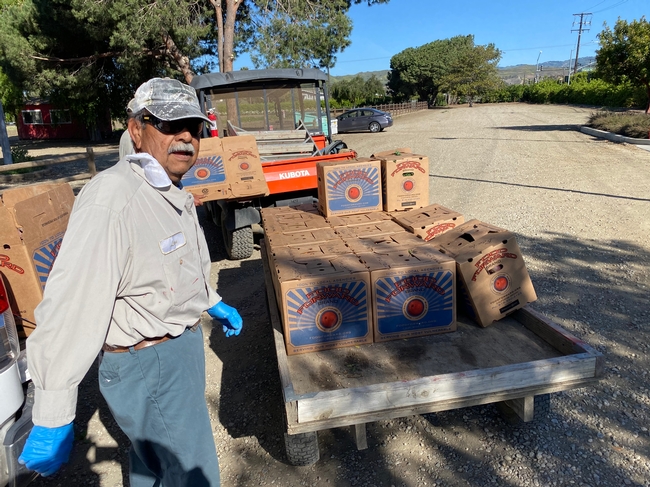
UCCE's education program manager Susana Bruzzone-Miller said, “We are saddened that spring field trip season is cancelled and miss the sound of children delighting in harvesting, sometimes for the very first time. But, it warms my heart that our field trip garden can help feed so many families in need.”
John Antongiovanni, farm manager, worked with the farm staff to organize the harvest. He said, “Working together during this difficult time is very rewarding.”
Food Forward is a gleaning organization that helps residents turn the surplus produce grown on their property into a nutritious food source for local communities. Rick Nahmias, founder and executive director, indicated that the Food Forward Backyard Harvest team remains active, and may be reached via phone at 805.630.2728 or email.

IMG 20200420 153035966 HDR
4-H Distance Learning Resources Available, Hedgerows for Healthy Soil and More
Online Educational Resources
Since we're all learning and working from home, our education team has created a virtual learning page packed with wonderful resources about agriculture. You can enjoy these lessons and stories from your computer, tablet or phone. Check back often, as we're adding content.
The Buzz About Hedgerows
Hedgerows are an approved practice under California Department of Agriculture's Healthy Soils Grant Program. That means, growers are eligible to receive grant funding for planting hedgerows. But what exactly are the benefits of hedgerows and why are they worth planting? As a perennial planting it can have immediate impacts on the soil, but what else? The answer lies largely in the pollinators and beneficial insects they attract.
Read the latest from our #climatesmart #ag community education specialist Alli Fish.
Resources You Can Use
University of California researchers and program staff are working to answer questions and provide information and resources relating to the food system and COVID-19. Check out this post, which contains resources about food and farm safety, gardening and more.
UC ANR Expands the Role & Reach of its Sustainable Ag Program
University of California vice president for agriculture and natural resources Glenda Humiston has announced changes to UC ANR's Sustainable Agriculture Research and Education Program (SAREP).
"Since 1986, SAREP has supported scientific research and education to advance agricultural and food systems that are economically viable, sustain beneficial ecosystem services, and enhance the quality of life in local communities. Moving forward, California farms and food systems face an ever-larger set of challenges: shifting consumer demands,invasive pests, climate change, additional regulations, lack of access to labor, and more. The need for new technologies, better systems and effective problem-solving is greater than ever.
“UC ANR envisions positioning SAREP to serve as a much broader umbrella of sustainability, addressing all aspects of the triple-bottom-line: people, planet and prosperity,” Humiston said. “To accomplish this, SAREP will provide leadership and support to several promising initiatives and will facilitate our ability to capture synergies among them. Those include agritourism, ecosystem services, regional food systems, community and economic development and more.”
The full announcement is available here.
Are You Following Us on Social Media?
We'd love to see you on Facebook and Instagram. Follow us for news and information you can use.
Have a great week!
Celebrate Earth Day with Gardening and Other Stay-at-Home Resources
This week marks the 50th anniversary of Earth Day. This year, consider celebrating the day with gardening and other stay-at-home resources curated by your local UCCE office.
History of Earth Day
Earth Day was launched in 1970. Many factors contributed to the call for a national day focusing on environmental stewardship, including the publication of Rachel Carson's Silent Spring - serialized in the New Yorker - and the catastrophic oil spill that occurred off the coast of Santa Barbara in 1969. The Santa Barbara oil spill galvanized U.S. Senator Gaylord Nelson (D-Wisconsin) to call for a national day of locally inspired and organized "teach-ins" on the environment - a national "Earth Day." The Earth Day model was inspired by the spirit of campus activism at the nation's colleges and universities. It wasn't top-down, but rather a grassroots effort that encouraged communities to develop educational and service events around issues and topics important to them.
Earth Day struck a chord; some estimates suggest that 1 in 10 Americans participated in the first events. Earth Day is widely credited with "sparking" the modern environmental movement. Landmark environmental legislation swiftly followed (including the Clean Air Act, Clean Water Act and Endangered Species Act). The Environmental Protection agency was founded that same year. Twenty years after its launch, Earth Day became a global movement.
You can learn more from the Earth Day Network by linking to this website.
Home Garden Resources
There is a wave of renewed interest in gardening as a result of the COVID-19 pandemic. Learn more about "crisis" gardening - and a new "Victory Garden" movement - in this article from the New York Times.
Closer to home, we have a wealth of gardening resources for you.
One of our favorites is the California Garden Web, designed by our UC Master Gardeners. You'll find a wealth of gardening information and a helpful glossary.
Ventura County is blessed with a wonderful growing climate and many of us have backyard fruit trees. Learn more about cultivating and caring for your home orchard here.
Resources for the Home Classroom
Many of us are working with our children in home classrooms. The UC 4-H Youth Development Program has a range of resources available to engage young learners. In honor of Earth Day, take a look at our 4-H Vegetable Gardening Project sheet. We also recommend our 4-H Water Conservation Project sheet, which provides engaging, science-based activities the entire family can enjoy. 4-H is one of the oldest youth development programs in the nation and we'll be sharing other educational resources in upcoming posts. #Head #Heart #Hands #Health.
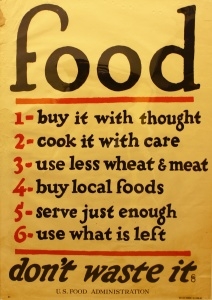
Be Kind to the Earth by Reducing Food Waste
Nearly 40 percent of the food produced in the U.S. is wasted and much of that waste ends up in landfills (definitely not good for our environment or the economy).
The National Resources Defense Council estimates that the average family of four throws out nearly 1,000 pounds of food each year, wasting roughly $1,500.
Consumers as a group waste more food than farms, grocery stores or restaurants. For tips on ways you can reduce #FoodWaste, click here.
History lesson: The image on the left is a poster that was used during World War I and World War II to promote food conservation. First printed in 1919, it contains tips that are helpful today.
This image is from a collection held by the Museum of County. Photographer: Aysen Tan.
Related reading: What a World War I Poster Can Teach Us About #FoodWaste.
Thank you, Volunteers!
This week is National Volunteer Week and we want to thank the hundreds of volunteers who are part of UCCE Ventura...and who make our work possible. Thanks to our 4-H, Master Gardener and HAREC volunteers. You are central to our mission and we value you. Youth, Families and Communities Education Program Manager Susana Bruzzone-Miller created this video to express our appreciation.
COVID-19 Resources
Our COVID-19 landing page provides links to important resources about the pandemic, including information for the agricultural community. In response to the coronavirus (COVID-19) illness, our office is closed for face-to-face service through May 15th. While we regret the inconvenience, these are the precautions we are taking to support one other and comply with University, local, county and state government recommendations. Our staff is telecommuting and can be contacted via phone and email. We are here to serve you.
Stay safe.
Thank you UC HAREC Volunteers
Dealing With COVID-19 in Agriculture and Home
The University of California has put together a series of publications on addressing COVID-19 in the home and the workplace. They can be found at: COVID-19 Guidelines
The individual articles are below:
Preventing Spread of COVID-19 in Households
Safety Gyuidelines in Agriculture During COVID-19
Food Safety Guidelines for COVID-19
Filing for Supplemental Pay During ShutDown
Take Care and Stay well.
And from CDFA:
Coronavirus Resources for Food and Agriculture page
BEST PRACTICES GUIDELINES
Food producers and manufacturers have been required by longstanding federal and state laws and regulations to prevent anyone who is sick or has a communicable disease from handling, processing or preparing food for human consumption. Thus, industries handling food and agricultural commodities are well practiced at this important and general principle of food safety and hygiene. It is important to follow recommendations as set forth by the CDC as well as those outlined below:
- Maintain diligence in good hygiene, monitor for employee illness, and adhere to social distancing guidelines as possible.
- Adhere to your Sanitation Standard Operating Procedures (SSOP), ensuring that those supervising staff and operations are vigilant in their oversight.
- Ensure adequate frequency of cleaning and sanitizing per CDC Environmental Cleaning and Disinfection guidance.
- Adhere to cleaning and sanitizing frequency of restroom and other high contact areas.
- Consider ways for employees to easily identify themselves (business card, company ID badge) outside of business operations for ease in transportation to and from work while adhering to local ordinances.
According to both the U.S. Centers for Disease Control (CDC) and the United States Department of Agriculture (USDA) there is currently no evidence to support transmission of COVID-19 associated with food or food packaging. The CDC is also reporting that, in general, because of poor survivability of the coronavirus on surfaces, there is likely a very low risk of spread from food products or packaging that are shipped over a period of days or weeks at ambient, refrigerated, or frozen temperatures.
Labor is a vital component to the food supply, from farm to fork. California has among the highest standards for food safety, which includes worker health and hygiene standards supported by labor laws that are very specific about paid sick leave for those individuals that may be affected by COVID-19 and unable to work.
Transportation: Governor Newsom's Executive Order on transportation “to allow timely delivery of vital goods” is also an important part of this discussion.
For additional information and FAQs please visit:
https://www.whitehouse.gov/wp-content/uploads/2020/03/03.16.20_coronavirus-guidance_8.5x11_315PM.pdf
https://www.cdc.gov/coronavirus/2019-ncov/community/organizations/businesses-employers.html
https://www.cdc.gov/coronavirus/2019-ncov/faq.htmlhttps://www.usda.gov/coronavirus
Photo: San Luis Obispo landscape

SLO image

